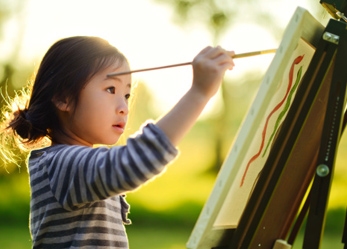Art Makes Smarter Kids
Work with art and get in touch with esthetic visual has a great impact on kids’ future life. So, start from earlier, or maybe from now (better late than nothing, right?) to teach art to them, Superparents. Just what are the benefits?
Motor Skills: There are many motions in art. Take the way to hold paintbrush or how to move crayon the paper, they are very essential for kids’ motorist development. In the age of three years old, kids usually start learning how to use scissor safely. In the next year, kids should have been able to draw a square and cut through straight line. Now, check out there. Many preschool no longer see scissor as forbidden item, instead they urge the use of scissor (in safe way), since it’s proven to be a good exercise for motorist skills and a good bait for them to learn writing.
Development of Language: For kids, doing art -or perhaps simply talk about it- means to open opportunity to learn things around colors, shapes, and moves. In fact, since they are one year old, we can start the practice to make simple art, and enriches the vocabulary when we are at it. For example, scrambled folded paper is called ‘ball.’ By the time they enroll in elementary school, kids should be able to use more advance words to express their work or talk about art.
Decision Maker: Art enhancing our skills in problem solving and critical thinking. The experience of choosing and making decision in art process do give impact to their life. “Set free the kids to explore, think, experiment and try out new ideas. It gives the creativity in them window to grow and expand,” said MaryaAnn Kohl, an art teacher and author of book about kids’ art education.
Visual Learning: Drawing, making shapes out of clay, tucking thread into beads, all also serves to build the crucial spatial-visual skills. Today’s kids are customized with smartphone, you know. They are also good at using tablet, while they don’t even know alphabet. It means they learn from the visual information. The info comes from symbols on the drawing or three dimension objects appear digitally on screen or book. “Art education teaches how to interpret, criticize and take advantage of visual information. Also, how make decision based on all of them.” said Dr Kerry Freemdman, The Chief of Art and Design Department in Northern Illinois University.
Think Out of the Box: When kids are being pushed to express their self and taking risk in art work, meaning they are building sense of innovation. “They will be people who keep moving forward, always look for new ways and not just follow the lead,” Kohl convinces. “Art is a way to encourage kids to walk down that path so they can experience the grand of thinking process.”
Cultural Awareness: Since place where we live in are rich with cultural variety, image of every community can contain a lot of message. “If kids play with blond haired dolls, slant eyes dolls and dark skinned dolls, they are learning about art esthetic of color, shape and hair textures,” said Freedman. That is why introducing kids to artist from many areas is important. Kids will come to understanding that an art work they see may comes from interpretation of someone to the surrounding reality.
Academic Success: Kids who regularly come in contact with art (a weekly dance class, drawing every three days, piano class in the weekend and such) have four times greater chance in academic achievement. Many of them compete in math and science and not few are awarded for what they accomplish for their essay of poem.
HAFIDA INDRAWATI
PHOTOS: THINKSTOCKS PHOTOS


 Indonesia
Indonesia















